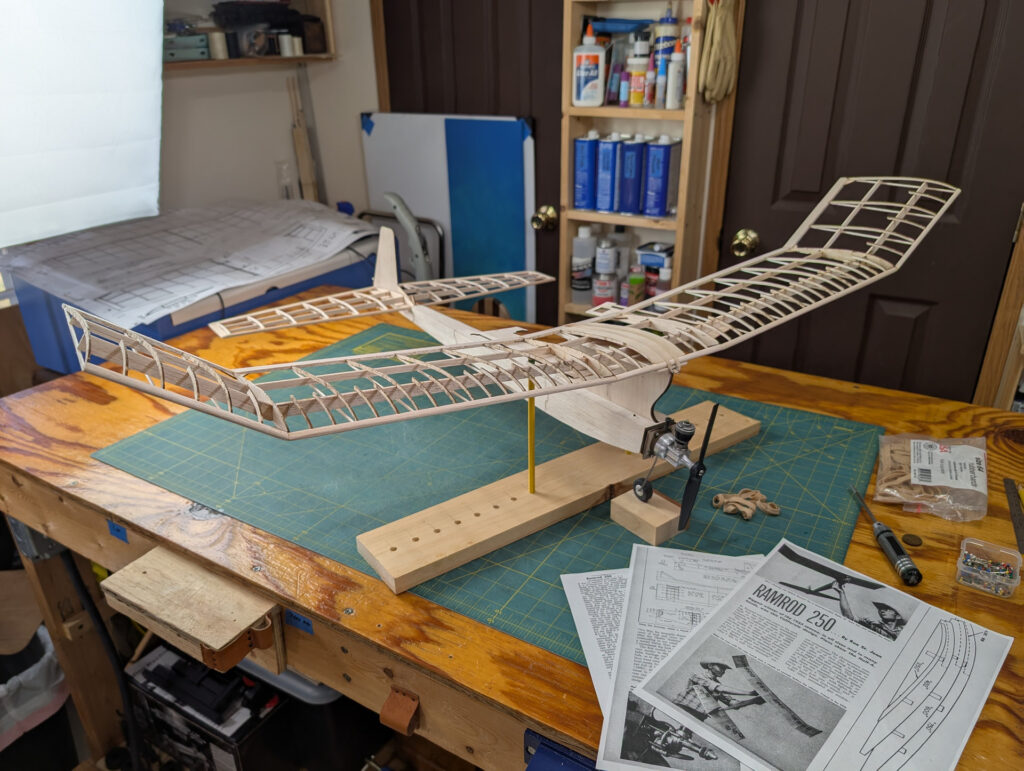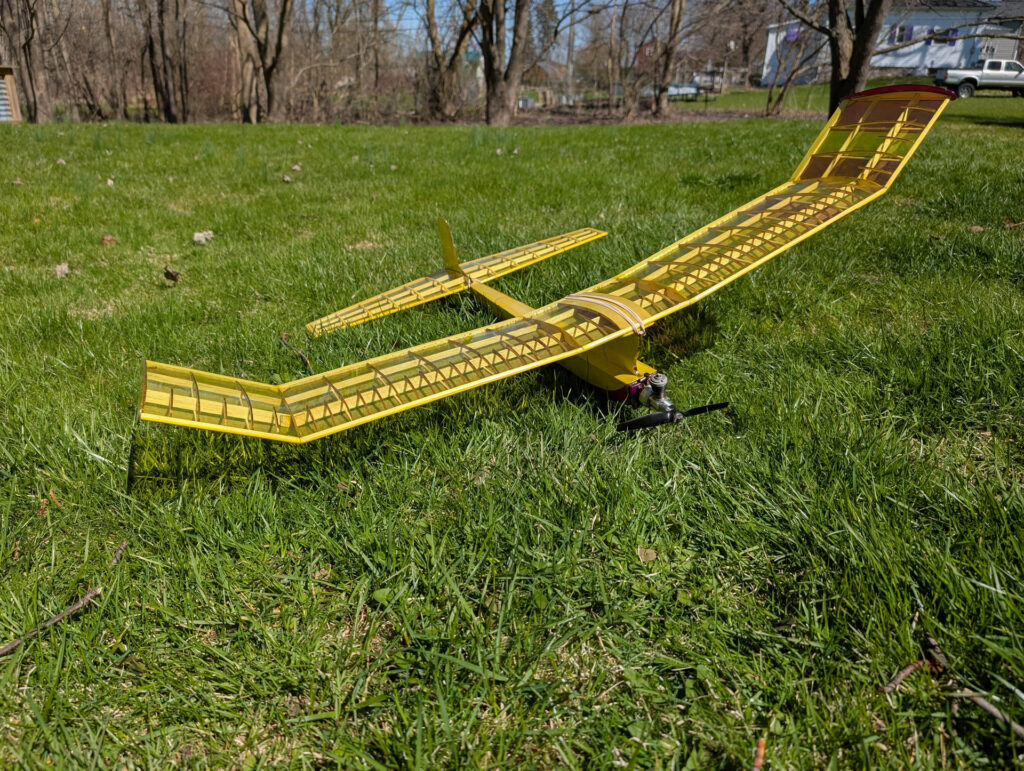Rediscovering the Ramrod: A Free Flight Journey Through Time

Why did I decide to build this airplane? Simple—because I never had. No, seriously, I needed to gain experience building balsa wood airplanes, and I thought this would be a good way to learn. Ever since I did a little indoor rubber-powered free flight flying, I’ve been fascinated by the whole process. See, once that airplane leaves your hand, you’re no longer in control. You’d better hope you trimmed it right for a graceful, predetermined circle—or you might just kiss all that hard work goodbye.

Okay, maybe not as dramatic as it sounds, but still. Ideally, you patch it up in the field and head home with only a few dings. Worst case? You go home without the airplane and return to your bench, ready to start another build. I’m sure plenty of you free-flighters out there know the feeling. And if you’re not into free flight yet, I highly recommend giving it a try!

This post isn’t about my Ramrod 250 build—that’s a story for another day. Today, it’s about the people, the place, and the time when the Ramrod design first made waves back in the 1950s. So let’s take a look at the history of the famous Ramrod—or more importantly, its designer, Ron St. Jean—as told through the memories of Lee Hines and Clint Brooks.
The Little-Known Ramrod Story
From my perspective… by Lee Hines

This is the story of the first known drawing of one of the greatest free flight designs of all time, Ron St. Jean’s famous Ramrod.
I have told this story to many of our free flight friends, but never wrote it out until now. Recently I called Ron, who recalled and verified this tale, when asked about Ramrod background.
To set the historical perspective, I moved to California in 1953 from Omaha, NE. A raw neophyte, I was trying my hand at free flight building and flying with some 1/2A kits, gliders and rubber jobs. I entered some contests with limited success, but kept trying to get help from many-especially Sal Taibi, Hal Cover, F.L. Swaney, Dick Petersen and others. The 1954 San Valeers Annual was held on November 6 & 7 at El Mirage Dry Lake. It was a big contest and as I took it all in I saw the most unusual and exciting airplane of my short life. It had a big Kiwi-shaped stab, 5-panel wing with TIP PLATES (!), a K&B .35 with 10 degrees of DOWNTHRUST (!), VTO pegs and was covered in purple silk with ‘RAMROD’ in big letters on the wing!
The flier started the engine, VTO’d it from those pegs and as I watched it rocket up in awe, I said “I want one of those and I want it NOW!” I quickly went up to the man to introduce myself and ask for plans, etc. That was how I met Ron, who had come from Wyoming a few years prior to work for Lockheed. He said he had designed and built this model some months before (which I believe was the first Ramrod ever), but no drawing existed yet, just rough notes and bench markings!
I begged him for a drawing, since the 1955 NATS were seven months away and I wanted to build a Ramrod fleet. He said OK, he would make the drawing and we exchanged phone numbers and addresses and went back to flying. In the course of events at the SV Annual I won the Senior Sweepstakes prize, which I traded for a Torp to power my future Ramrod. Ron unfortunately lost his 750 Ramrod that night during night flying when the light went out on the model.
Well, I went home and cleared off my workbench, anxious to start my first Ramrod, which I knew would be the plane of my dreams! December passed, then January and I called Ron to inquire about the status. He said he was very busy at Lockheed and I think, forgot about the Ramrod drawing but he would do it and send it soon.
February came an went, I am getting as impatient as any 16-year-old could, so I called Ron again, pleading for the drawing. He is a very nice man, getting bombarded by a request for a drawing while having little extra time to do so, which I, a callow youth, of course cannot fathom why it is not done yet!? Things must have been very busy for him at this time, because April went and May came with still no drawing! I AM PANICKED! And he could tell when I called, probably by my squeaking high pitched voice begging him!
Well, about the time of my birthday in early June, there came an envelope from Ron. Boy was I relieved. In it was an 8.5 x 11 brown line copy for the Ramrod 750, which I still have to this day. I immediately drew full size plans and built one by July 6th with only five degrees of down thrust (‘That should be enough’ thought I) which meant I had to ROG it initially. The extra five degree was added later on, so then I too could VTO launch it.
Still, it trimmed out easily, after my cautious first flights with the prop on backwards. Then I turned the prop around…. which produced barrel rolls to the left! Not crashing allowed me to get it right in seven more flights and I was in heaven, as it was by far the best performer I ever had. In fact, that test day Merrill Combs, a fellow club member, saw it fly and was impressed as well. He asked to borrow the plans and the next week he had his flying too.
So, we went to the ’55 Los Alamitos NATS with the first and second Ramrods anyone had made, aside from Ron St. Jean himself. I cannot recall what Ron or Merrill did at the NATS, but I was fortunate to take second place in Class B and fifth in Class C Senior, with my 750 Ramrod, the first built from the first ever Ramrod drawing.
After returning home I drew plans scaled from that first Ramrod drawing, building various sizes with equal success to my 750. In fact, several of our group found that the 250 size from MAN plans gave them trouble which I never had on my versions. On investigation, as I recall, the stab and tail moment were bigger on the MAN version, not to scale from the 750, as were my models.
So, my suggestion is to those who want to build a Ramrod, in the future use the 750 drawing as your basis design and construction. It should give you more flying ability and pleasure-mine sure did!
Lee R. Hines
12 Sept, 2003.
Addendum to the Ramrod Story by Clint Brooks
Information taken from a logbook kept by Lee throughout the time he built and flew the Ramrod design.
From the period of July 1955 through February 1957 Lee designed and flew versions of the Ramrod 750, 600, 425, 350 and 250. All of these iterations appeared to come shortly after finishing the 1955 NATS and no doubt fueled by his intense enthusiasm for the success of his first 750 Ramrod.
He kept records on what appears all the contest and practice flights he made with each of these models, noting trim changes, problems and solutions he had during these sessions. It’s too much to capture for this document but suffice to say I doubt there is anything like this in the world for how to raise and fly a Ramrod model if someone wants to dig into the minutia of ‘how it went’ back in the day.
Lee kept track of his average flight times as he put in flights on each Ramrod he made. Here is what he recorded for various versions:
“Average Flight Time for Ramrod 750 B-C FF”
After 25 official flights: 4:44.5 minutes / 284.5 seconds
After 30 official flights: 4:48.8 minutes / 288.8 seconds
After 46 official flights: 5:14.4 minutes / 314.4 seconds
After 97 official flights: 4:56.7 minutes / 296.7 seconds
“Average Flight Time for Ramrod 600 A-B FF”
After 27 official flights: 4:09.4 minutes / 249.4 seconds
After 31 official flights: 4:38.4 minutes / 278.4 seconds
After 38 official flights: 4:32.2 minutes / 272.8 seconds
After 41 official flights: 4:29.3 minutes / 269.3 seconds
After 47 official flights: 4:29.4 minutes / 269.4 seconds
No average time record on the 425 Ramrod-model eventually destroyed by D/T under power in late 1957.
No average time record for the 350 version Ramrod. Model started life powered by a POGO .085 engine then upgraded to a new Torp .09 Greenhead after the Pogo proved inadequate for power. Model eventually lost during the 1957 NATS at Willow Grove PA.
“Average Flight Time for Ramrod 250” (three built and flown) Cox Thermal Hopper .049 power.
Average (overall) official flight time: model No. 1 (5:17.1 minutes / 317.1 seconds) I believe this is for Model No. 1 eventually lost OOS in Feb 1956.
Model No. 2 flew in the 1956 Dallas NATS and eventually had a final hard crash and end of record keeping in February 1957.
Model No. 3 has no contest records and ended up in a tall tree and lost during one of the many practice sessions performed with it, in February 1957.
This ends the record on Ramrods for Lee and it must have been around this time his interests shifted to glider events and even more historic efforts in that branch of aeromodeling. Lee set up several of his 1/2A ships for ROW and appeared to interchange floats for various contests to compete in ROW.
I did not realize the depth of background Lee has on the Ramrod design until I told him I was going to do an eNos version of the 250. As we often carpool to Perris for FF practice and local contests. I eventually got all the fragments of the story from him during the commute time.
There is a tremendous amount of SoCal free flight history woven in these stories and it’s a shame it can’t all be captured-there were many notable designers and fliers who emanated from these parts-no doubt living in a weather friendly area helped foster this community in the 40’s and on.
Living in the twilight of this Golden Age I am honored to have this history presented to me -it’s like having my own little window on the past, even though I was not even a year old when this story starts.
Researching and designing the eNos version of the Ramrod brings forth more than lines and numbers-it keeps the past in the current day and a way to re-discover the wonder this model offers to anyone who wants to construct and fly it.
Reading through the stories from Lee Hines and Clint Brooks gave me a deeper appreciation for the legacy behind the Ramrod. It’s one thing to build a model airplane—it’s another to realize you’re building a piece of history. Every time I shape a rib or glue a spar, I’m not just following a plan—I’m retracing the steps of legends who helped shape the golden age of free flight. And maybe, just maybe, my own Ramrod 250 will earn its wings in honor of those who flew before me.
If you’re even half as intrigued by this story as I was, I encourage you to dive into your own free flight project. There’s a whole world of sky out there waiting.
Discover more from Buffalo Air-Park
Subscribe to get the latest posts sent to your email.

